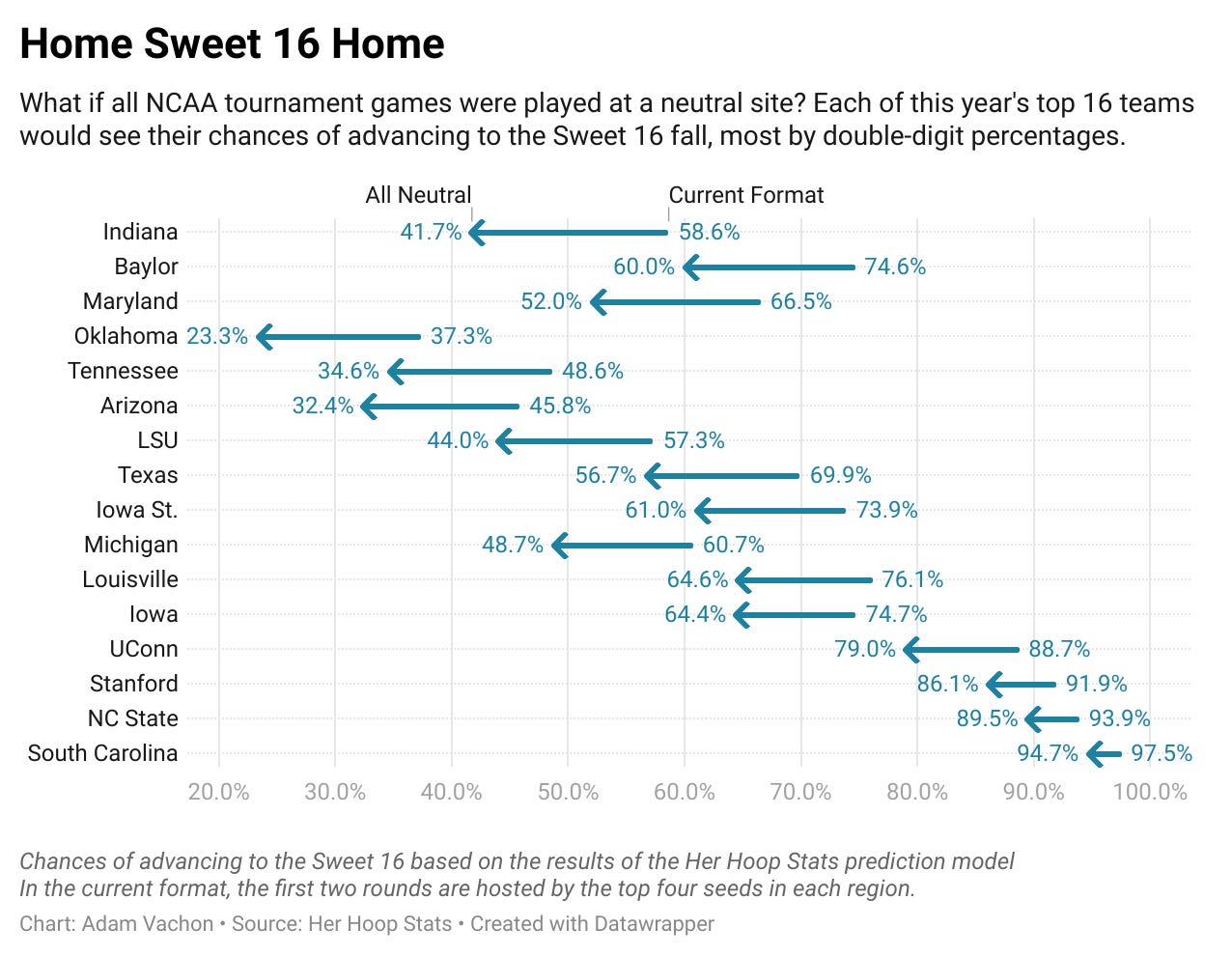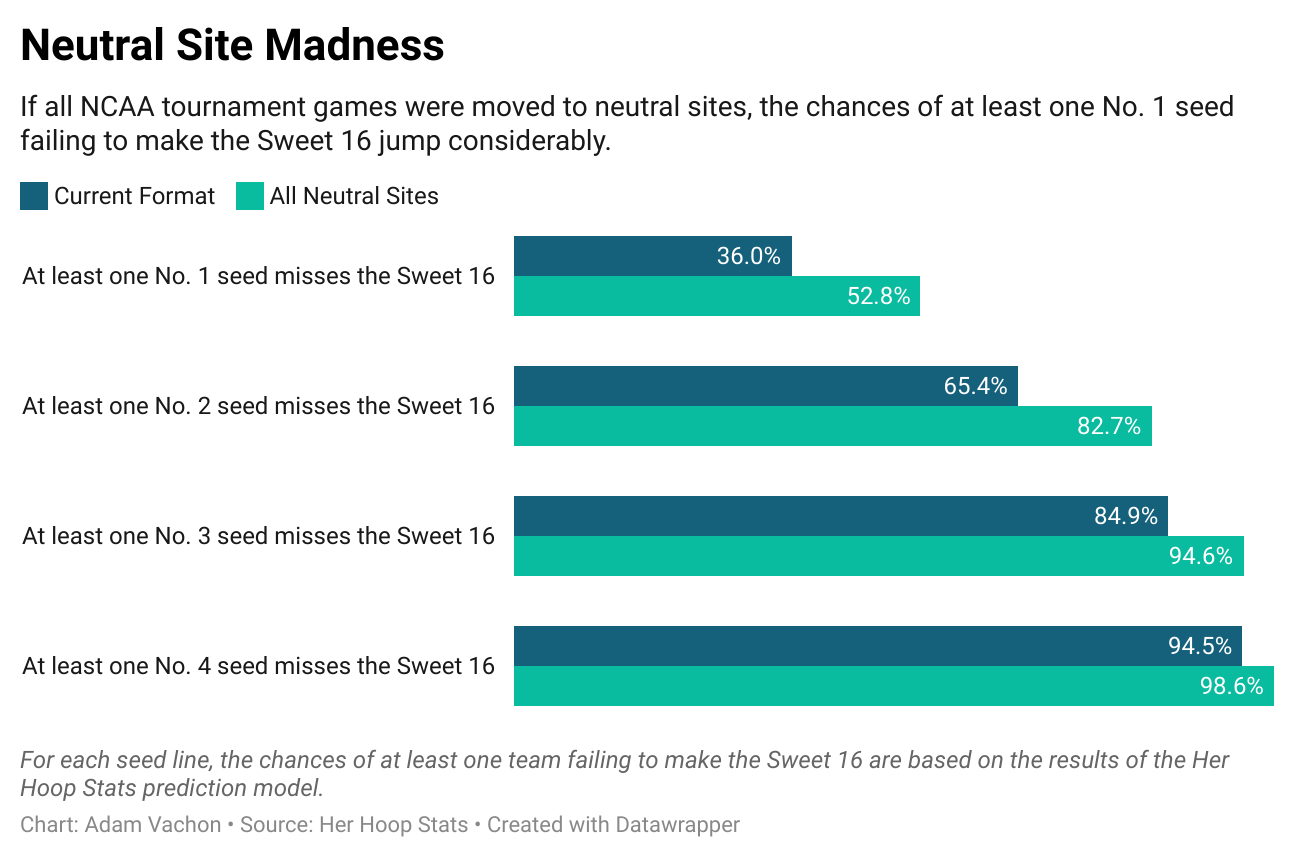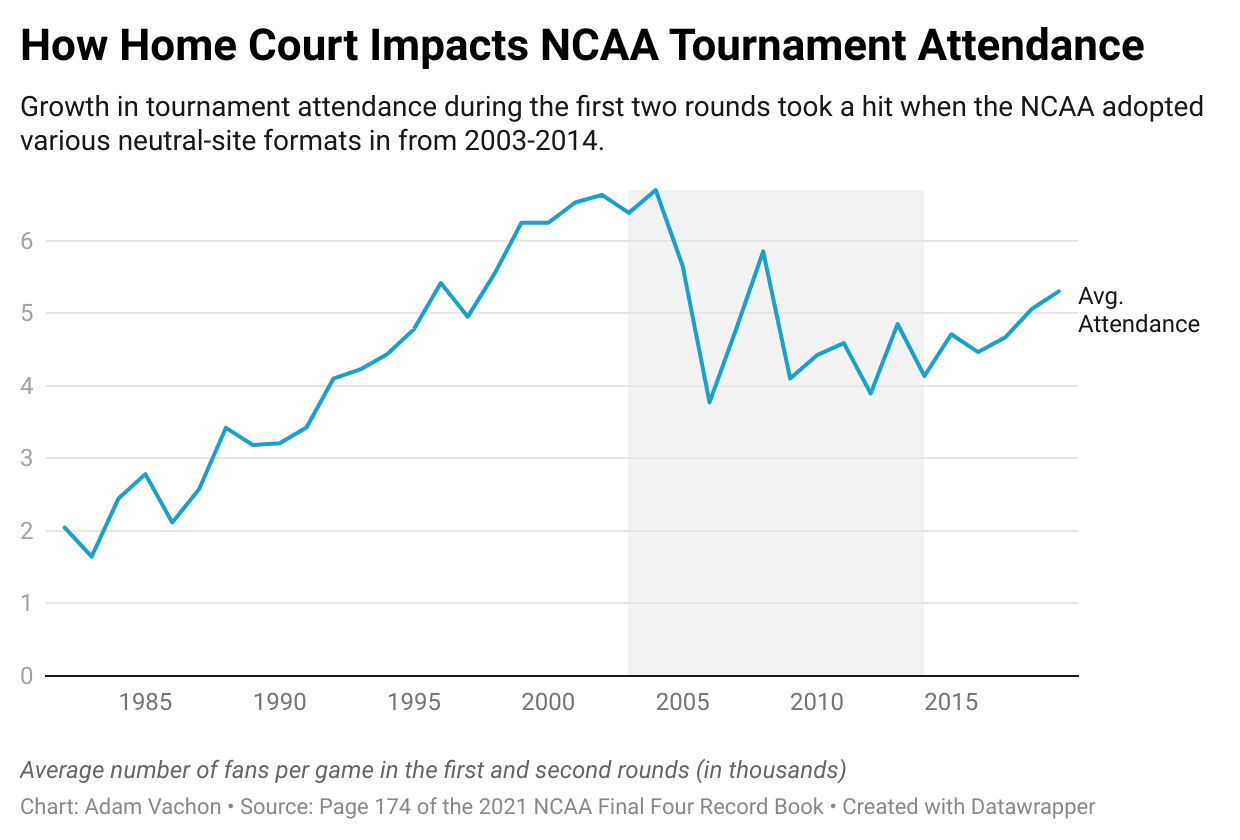Home Court or Neutral Site: That is the Question
Analyzing the impact of home-court advantage on upsets and whether the NCAA should adopt an all-neutral-site format
Thanks for reading the Her Hoop Stats Newsletter. If you like our work, be sure to check out our stats site, our podcast, and our social media accounts on Twitter, YouTube, Facebook, and Instagram. You can also buy Her Hoop Stats gear, such as laptop stickers, mugs, and shirts!
Haven’t subscribed to the Her Hoop Stats Newsletter yet?
Last year, I claimed that if Family Feud were to ask fans what they love most about March Madness, upsets would be the number one answer. While I never had the opportunity to enlist the services of Steve Harvey, I remain confident in this assertion. The answer is right there in the name: March Madness. Diehard and casual college basketball fans alike revel in the uncertainty generated by a compelling underdog story.
While the NCAA tournament has delivered countless thrilling moments in the past, upsets have been rare. No 14-seed or worse has ever advanced past a first-round game, and only seven No. 13 seeds have managed to knock off a No. 4 seed. No team worse than a No. 3 seed has captured the NCAA title, and the past nine champions have all been No. 1 seeds. So, why the lack of madness? Also, are there tournament structure changes that can address this issue, and are such modifications optimal from an audience growth perspective?
The impact of home-court advantage
With respect to the shortage of upsets, many observers will point to a low level of parity, with only a handful of teams having a realistic shot of hoisting the trophy in April each season. While there remains some merit to that argument, a review of Her Hoop Stats Ratings this season across different groups of teams suggests that narrative appears to be changing. The other major factor influencing the paucity of unexpected results is home-court advantage. In 26 of the tournament’s 39 iterations (including the six of the last seven), the top four seeds in each region have hosted early-round games. This reduces the likelihood of first-round upsets, and it also nips several potential Cinderella runs in the bud by placing early-round underdogs in difficult road environments.
But what if this season the NCAA had adopted a tournament format where all games occurred at neutral sites, akin to the men’s model? The Her Hoop Stats prediction model enables us to explore that hypothetical. In particular, let’s take a look at the top 16 teams and the impact such a change would have on their prospects of advancing to the Sweet 16.
In short, the road to the Sweet 16 would be much tougher for this year’s top 16. The majority of these teams would see their chances of reaching the regional semifinal plummet by double-digit percentages. Another way to conceptualize this is to look at the chances that at least one team within a given top-four seed line loses in the first two rounds. The Her Hoop Stats prediction model gives a 36% chance to at least one No. 1 seed falling in the first two rounds, driven largely by Louisville having just a 76% chance of making the regional semifinals (the other No. 1 seeds each have at least a 90% chance). Switch all games to neutral sites and the chances of at least one No. 1 seed failing to qualify for the Sweet 16 jump to slightly better than a coin flip.
We’ve now established two things. First, fans love upsets. Second, moving all NCAA tournament games to a neutral site considerably increases the likelihood of upsets. So, it sounds like a no-brainer to make this change immediately. Unfortunately, it’s not that simple.
The attendance issue
The topic of moving to a pure neutral site format arose during press conferences at last year’s tournament (which itself took place at neutral sites due to the pandemic). Some coaches explained why such a move would be counterproductive to the primary goal of drawing fan support.
"In every [other] sport in the NCAA, you don't have neutral sites in the first couple rounds," UConn coach Geno Auriemma said. "Because it happens in men's basketball [which is at neutral sites for the duration], people just assume it's supposed to happen in women's basketball. But it'd be terrible to have games at neutral sites and have what you have here now, a quiet gym."
Dawn Staley echoed Auriemma’s sentiment and commented on the importance of rewarding regular-season performance.
"Am I in favor of it [moving to a neutral site format]? Nope," Staley said. "That's what you work for. It gives an extra incentive during the season to pack the house. We draw a big crowd, we've been No. 1 in attendance the past six years. Let's not take our game backwards."
South Carolina and UConn ranked No. 1 and No. 4, respectively, in attendance during the 2019-20 season. A cynic might suggest that Staley and Auriemma are solely motivated by protecting the significant home-court advantage their programs enjoy. However, there is something to their comments, particularly Staley’s plea to avoid taking the women’s game backward. The NCAA implemented a variety of different formats during the period 2003-2014, moving away from the top 16 seeds hosting the first two rounds. This included 2005-2008 when it adopted the men’s tournament model. The attendance growth enjoyed during the late 1990s and early 2000s slowed and, ultimately, attendance fell, prompting the NCAA to abandon the change in 2015.
Still, recent growth in attendance and TV viewership suggests we might have reached a point where the all-neutral-site experiment is worth another go, especially if the sites are strategically chosen. Oregon coach Kelly Graves expressed this perspective last year.
"What makes the men's NCAA tournament what it is, is those early-round upsets," Graves said. "In the end, it's usually the better teams that make their way to the Elite Eight and the Final Four, but those early-round upsets are what makes the tournament great…It's hard enough for a 13 to beat a 4, or a 15 to beat a 2. But then when you have to do it on that higher seed's floor, it's next to impossible. With the way the game has grown, if you pick those spots wisely, I think you can grow and make it special."
Where do we go from here?
The overarching question revolves around the most effective way to grow the game of college women’s basketball long-term. Upsets and Cinderella runs generate excitement and draw attention to programs that otherwise receive little attention, which in turn helps create new fan bases. Removing home-court advantage from the NCAA tournament equation would produce more upsets, which feels like a sure-fire way to produce long-term growth. Though, it runs the risk of thwarting the recent hard-earned gains in attendance and TV viewership. NCAA college women’s basketball is getting closer to the point where it can absorb the loss in attendance to realize the aforementioned benefits of an all-neutral-site tournament structure. Surely, college basketball fans would welcome with open arms a little more madness in March.
Thanks for reading the Her Hoop Stats Newsletter. If you like our work, be sure to check out our stats site, our podcast, and our social media accounts on Twitter, YouTube, Facebook, and Instagram.







Neutral site success also requires one other major step: A move from Our Girls' Syndrome, where fans are only interested in their team, to a much broader interest in the women's game. If that were to happen, then ticket-buyers would be interested in women's basketball as a whole and not just the team they follow. Sadly, the evidence for this is lacking, as in most conference tournaments, fans don't stick around to watch other games -- they watch their team and then leave.
If they do that in conference tournaments, where they presumably have some knowledge of and connection with other teams (even if they want a particular team to lose), what would happen when the teams in the next game are from 2,000 miles away?
I also understand that attendance at the men's neutral sites has been an issue. It costs a lot to travel on short notice, so attendance is heavily linked to local interest. (And "local interest" is somewhat linked to gambling and betting on games, which doesn't happen nearly as much for women as it does for men.)
I do think there's growing interest in the women's game, but I don't know that playing tournament games in front of crowds less than those at high school playoff games will foster that growth, or hamper it.
1. TV money keeps our sport going. Viewers - regardless of their team preference desire the affirmation that this game - and by extension the tournament really matters. Empty gyms send the opposite message. Huge nearly-vacant arenas are considerably worse. Networks meanwhile, are only going to pay if lots of people care ... and part of the way that they judge that is tickets sold and screaming butts in seats. This is why nearly every commercial break begins and ends with a "fan shot". Clips of those seven-year old kids in heart wrenching tears over the Kentucky men's loss are as enduring as the fall-away three that sealed their fate in OT. Fairness and upsets will be meaningless if engagement and passion aren't nurtured.
2. The NCAA tournament is at most seven games for any team and their fans. The ~30ish other games are mostly played at home arenas. This isn't accidental. To grow the sport, we need people to participate. Dawn has done wonders in her part of filling that home arena. Yes. Part of that is winning, but another part is taking steps to engage the fans, making players accessible, telling them that the team appreciates them coming out. Vic took MSST from a couple hundred parents and friends to a regularly full arena, and is building similar momentum in Texas now. Hometown crowds are critical for such advances.
3. This is really a question of degree. Should the entire tourney be neutral, or just the FF? The new play-in games are already neutral, because participants are by-definition not high enough seeds to earn a home date. Look at the data, first and second round upsets are on the rise already. All the talk about UCONN potentially playing the regional rounds in-state is interesting, but why do you suppose Bridgeport wins the bidding to be a host? Tinfoil hats aside, it is because they continually get fervent crowds that fill their seats, buy their hotdogs, and stay in nearby hotels. This is not lost on the NCAA, who are planning to revise the regional siting, but have planned Greensboro South Carolina as a "neutral" site in the coming years.
4. Are there really neutral sites at all? Every significant city in the country has an NCAA team (or a dozen) nearby. We're not going to pay to have the entire event take place in Europe. And if we pick a great location like the Bahamas, do you really think that the two sides will be equally represented in their attendance?
5. Finally, let's talk fairness. Is it fair to a team that proves itself all year to be placed on equal footing with the sub- .500 team who got hot in their conference tournament? Will we start having a round-robin of the one-seeds to keep the most balanced? Then the twos, and so on, essentially running the entire bracket in reverse. That would be the most fair, but it fundamentally changes the event - and probably not in a way that benefits the growth of the sport.